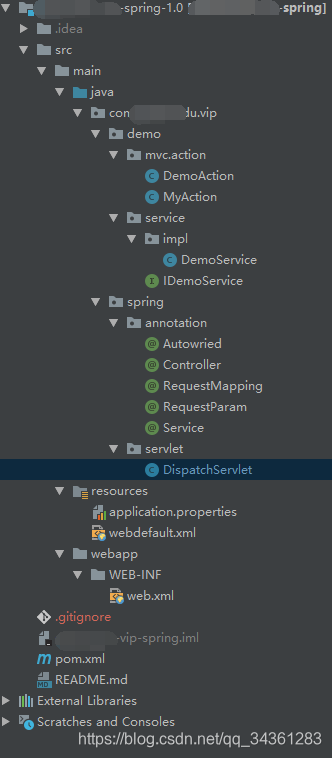前言
《SSM源码分析之Spring05-DI实现原理(基于Annotation 注入)》
《SSM源码分析之Spring06-IOC 容器中那些鲜为人知的事儿》
前面的章节我们主要看了一下在spring源码是如何设计管理bean的。这节我们用简单的几个类实现一个核心的IOC功能~
手写SpringV1.0
准备工作
我们首先整理一下思路:

然后,创建一个maven项目,最后的项目结构如下:

pom.xml引入servlet依赖:
<properties>
<!-- dependency versions -->
<servlet.api.version>2.4</servlet.api.version>
</properties>
<dependencies>
<!-- requied start -->
<dependency>
<groupId>javax.servlet</groupId>
<artifactId>servlet-api</artifactId>
<version>${servlet.api.version}</version>
<scope>provided</scope>
</dependency>
<!-- requied end -->
</dependencies>
在web.xml中注册Servlet:(关于servlet这里不做过多解释,可以参考文章快速创建一个servlet并且在web.xml配置和使用它)
<?xml version="1.0" encoding="UTF-8"?>
<web-app xmlns:xsi="http://www.w3.org/2001/XMLSchema-instance"
xmlns="http://java.sun.com/xml/ns/j2ee" xmlns:javaee="http://java.sun.com/xml/ns/javaee"
xmlns:web="http://java.sun.com/xml/ns/javaee/web-app_2_5.xsd"
xsi:schemaLocation="http://java.sun.com/xml/ns/j2ee http://java.sun.com/xml/ns/j2ee/web-app_2_4.xsd"
version="2.4">
<display-name>Spring Application</display-name>
<servlet>
<servlet-name>mvc</servlet-name>
<servlet-class>com.xxx.vip.spring.servlet.DispatchServlet</servlet-class>
<init-param>
<param-name>contextConfigLocation</param-name>
<param-value>classpath:application.properties</param-value>
</init-param>
<load-on-startup>1</load-on-startup>
</servlet>
<servlet-mapping>
<servlet-name>mvc</servlet-name>
<url-pattern>/*</url-pattern>
</servlet-mapping>
</web-app>
application.properties配置文件:
scanPackage=com.xxx.vip.demo
templateRoot=layouts
DispatchServlet实现Bean的定位、加载、注册
public class DispatchServlet extends HttpServlet {
private Properties contextConfig = new Properties();
private Map<String,Object> beanMap = new ConcurrentHashMap<String,Object>();
private List<String> classNames = new ArrayList<String>();
@Override
protected void doGet(HttpServletRequest req, HttpServletResponse resp) throws ServletException, IOException {
this.doPost(req,resp);
}
@Override
protected void doPost(HttpServletRequest req, HttpServletResponse resp) throws ServletException, IOException {
System.out.println("---------- 调用doPost ----------");
}
@Override
public void init(ServletConfig config) throws ServletException {
//开始初始化的进程
//定位
doLoadConfig(config.getInitParameter("contextConfigLocation"));
//加载
doScanner(contextConfig.getProperty("scanPackage"));
//注册
doRegistry();
//自动依赖注入
//在Spring中是通过调用getBean方法才出发依赖注入的
doAutowired();
// DemoAction action = (DemoAction)beanMap.get("demoAction");
// action.query(null,null,"Tom");
//如果是SpringMVC会多设计一个HnandlerMapping
//将@RequestMapping中配置的url和一个Method关联上
//以便于从浏览器获得用户输入的url以后,能够找到具体执行的Method通过反射去调用
initHandlerMapping();
}
private void initHandlerMapping() {
}
private void doRegistry() {
if(classNames.isEmpty()){ return;}
try{
for(String className : classNames){
Class<?> clazz = Class.forName(className);
//在Spring中用的多个子方法来处理的
if(clazz.isAnnotationPresent(Controller.class)){
String beanName = lowerFirstCase(clazz.getSimpleName());
//在Spring中在这个阶段不是不会直接put instance,这里put的是BeanDefinition
beanMap.put(beanName,clazz.newInstance());
}else if(clazz.isAnnotationPresent(Service.class)){
Service service = clazz.getAnnotation(Service.class);
//默认用类名首字母注入
//如果自己定义了beanName,那么优先使用自己定义的beanName
//如果是一个接口,使用接口的类型去自动注入
//在Spring中同样会分别调用不同的方法 autowriedByName autowritedByType
String beanName = service.value();
if("".equals(beanName.trim())){
beanName = lowerFirstCase(clazz.getSimpleName());
}
Object instance = clazz.newInstance();
beanMap.put(beanName,instance);
Class<?>[] interfaces = clazz.getInterfaces();
for (Class<?> i :interfaces){
beanMap.put(i.getName(),instance);
}
}else{
continue;
}
}
}catch (Exception e){
e.printStackTrace();
}
}
private void doAutowired() {
if(beanMap.isEmpty()){ return; }
for (Map.Entry<String,Object> entry : beanMap.entrySet()) {
Field [] fields = entry.getValue().getClass().getDeclaredFields();
for (Field field : fields){
if(!field.isAnnotationPresent(Autowried.class)){continue;}
Autowried autowried = field.getAnnotation(Autowried.class);
String beanName = autowried.value().trim();
if("".equals(beanName)){
beanName = field.getType().getName();
}
field.setAccessible(true);
try {
field.set(entry.getValue(),beanMap.get(beanName));
} catch (IllegalAccessException e) {
e.printStackTrace();
}
}
}
}
private void doScanner(String packageName) {
URL url = this.getClass().getClassLoader().getResource("/" + packageName.replaceAll("\\.","/"));
File classDir = new File(url.getFile());
for (File file : classDir.listFiles()){
if(file.isDirectory()){
doScanner(packageName + "." +file.getName());
}else {
classNames.add(packageName + "." + file.getName().replace(".class",""));
}
}
}
private void doLoadConfig(String location) {
//在Spring中是通过Reader去查找和定位对不对
InputStream is = this.getClass().getClassLoader().getResourceAsStream(location.replace("classpath:",""));
try {
contextConfig.load(is);
} catch (IOException e) {
e.printStackTrace();
}finally {
try {
if(null != is){is.close();}
}catch (Exception e){
e.printStackTrace();
}
}
}
private String lowerFirstCase(String str){
char [] chars = str.toCharArray();
chars[0] += 32;
return String.valueOf(chars);
}
}
自定义注解
Autowried
@Target({ElementType.FIELD})
@Retention(RetentionPolicy.RUNTIME)
@Documented
public @interface Autowried {
String value() default "";
}
Controller
@Target({ElementType.TYPE})
@Retention(RetentionPolicy.RUNTIME)
@Documented
public @interface Controller {
String value() default "";
}
RequestMapping
@Target({ElementType.TYPE,ElementType.METHOD})
@Retention(RetentionPolicy.RUNTIME)
@Documented
public @interface RequestMapping {
String value() default "";
}
RequestParam
@Target({ElementType.PARAMETER})
@Retention(RetentionPolicy.RUNTIME)
@Documented
public @interface RequestParam {
String value() default "";
}
Service
@Target({ElementType.TYPE})
@Retention(RetentionPolicy.RUNTIME)
@Documented
public @interface Service {
String value() default "";
}
测试
Service层:
public interface IDemoService {
String get(String name);
}
实现类:
@Service
public class DemoService implements IDemoService {
public String get(String name) {
return "My name is " + name;
}
}
Controller层:
@Controller
public class MyAction {
@Autowried IDemoService demoService;
@RequestMapping("/index.html")
public void query(){
}
}
带参数测试
@Controller
@RequestMapping("/demo")
public class DemoAction {
@Autowried private IDemoService demoService;
@RequestMapping("/query.json")
public void query(HttpServletRequest req,HttpServletResponse resp,
@RequestParam("name") String name){
String result = demoService.get(name);
System.out.println(result);
// try {
// resp.getWriter().write(result);
// } catch (IOException e) {
// e.printStackTrace();
// }
}
@RequestMapping("/edit.json")
public void edit(HttpServletRequest req,HttpServletResponse resp,Integer id){
}
}
后记
本节springV1.0的代码地址如下:手写spring的ioc容器
在后续章节,我们依次手写实现spring的AOP、springMVC等核心功能
